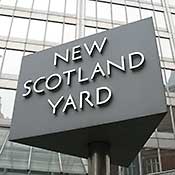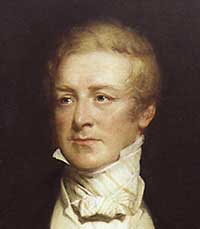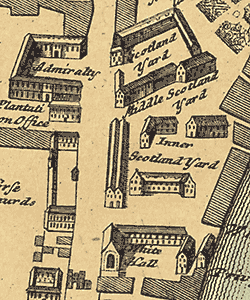How Scotland Yard Got Its Name.

Scotland Yard. The very name evokes images of intrepid detectives on the trail of master criminals. Londoners know the Yard as headquarters for their beloved Bobbies while mystery lovers see its operatives as allies and rivals of Sherlock Holmes and Hercule Poirot.
Scotland Yard is probably the most famous police service in the world. But what kind of name is that for a police department, especially one located hundreds of miles from Scotland?
Origins of London’s Metropolitan Police. It’s hard for us in the 21st century to imagine a major city without a municipal police department. But civilian law enforcement agencies are relatively new. London’s was organized in 1829 by then Home Secretary Robert Peel.

Peel made great efforts to overcome the concerns of people who feared a military-like force would infringe people’s liberties. For example, his officers wore blue uniforms that looked nothing like the red coats worn by British soldiers, and officers were required to wear their uniforms both on and off duty to allay fears that they were spying on people. These efforts were successful and the department became so closely identified with Peel that its officers were sometimes called “Bobbies,” after Peel’s nickname. Even today, nearly two centuries later, London police officers are often referred to as “Bobbies.”
A Back Door on Scotland Yard. London’s new police commissioners needed a place to work. When a private residence near government offices became available, Peel obtained it for use as a headquarters. The building’s address was 4 Whitehall Place, but it had a rear entrance opening onto a place called Scotland Yard.

People visiting the commissioners tended to use the Scotland Yard entrance. A waiting room called the Back Hall was built to accommodate them.
Elsewhere in the building, servants’ quarters were converted into a neighborhood station house. Its entrance was also on Scotland Yard and the officers who worked there soon began referring to their station house as Scotland Yard.
By 1830, newspapers and the public were using the names Whitehall Place and Scotland Yard to refer both to the headquarters location and the police department. By the time the department’s first detectives were assigned three rooms in the building in 1842, Whitehall Place had been largely dropped and the new investigators were referred to as Scotland Yard.4
The police force quickly outgrew its original quarters and expanded into nearby buildings. When no more space was available, a new headquarters was erected on the Victoria Embankment. But by that time the name Scotland Yard had become so much a part of the police department’s identity that the new location was renamed New Scotland Yard when they moved. The same was done again when headquarters were moved in 1967 and most recently in 2016.

How Scotland Yard Ended Up in London. The story goes back a thousand years to an English king’s gift of land along the Thames for King Kenneth III of Scotland to build a palace for his use on visits to London. Later Scottish kings stayed there while attending Parliament as English barons. The last member of the Scottish royal family to live there was Queen Margaret, a sister of Henry VIII.5
After Margaret, the Scottish royal family stopped using the palace and it fell into disrepair. When James VI of Scotland became King of England in 1603, he moved into the English royal palaces and the need for a Scottish palace in London ended.7 Some of the buildings were dismantled and replaced by government offices.
* * * * *
Place names sometimes continue long after their original meaning has been forgotten. Scotland Yard is just one. In New York, Wall Street was once the location of fortifications protecting settlers in lower Manhattan and Boston’s Beacon Hill was the site of a beacon tower that could be used to warn residents of impending danger (See Why Is Beacon Hill Called Beacon Hill?).
-----
- Sign in front of Scotland Yard’s headquarters building. Image from Wikipedia.
- Detail from painting by Henry William Pickersgill currently in the collection of the National Portrait Gallery. Image from Wikipedia.
- Image from postcard printed around 1914 by The Photochrom Company Limited. The title is Traffic Duty at Ludgate Circus. Information from the London Science and Media Museum’s web site.
- Information from Douglas G. Browne, The Rise of Scotland Yard, pp. 79–80, George . Harrap & Co. Ltd (1956).
- Information about the origin of the name Scotland Yard for an area in London comes from the Encyclopaedia Britannica article on Scotland Yard and Edward Walford, Old and new London : a narrative of its history, its people, and its places, Vol III, Chapter XLI, Scotland Yard and the Metropolitan Police (1873).
- Detail from 1736 London map by Homann Erben in the Harvard Map Collection. Digital image available through the Harvard Geospatial Library (link).
- Even though the crowns of England and Scotland were united in 1603, the countries remained separate kingdoms until the 1707 Acts of Union created the Kingdom of Great Britain.
This article originally appeared in our free semi-monthly newsletter. To receive future issues, please add your name to the subscription list.

